You’ve planned your injection molding project meticulously, but that final invoice is substantially more than your initial quote. Unplanned expenses for mold changes, rejects, and surprise fees have totally blown your budget. You’re frustrated and taken aback, afraid that the hidden costs will jeopardize your profit line. This unpredictability makes it difficult to be comfortable with what’s going on and plan your upcoming projects with confidence.
Complex part design, tight tolerances, high-cost materials, inefficient cycle times, mold alteration, high scrap rates, secondary operations, assembly, mold maintenance and shipping logistics are the ten most prevalent hidden costs in injection-molding. These must be controlled in a proactive manner that revolves around Design for Manufacturability (DFM). You can reduce the cause of these unplanned costs by making sure that your part design is optimized to the molding process at the earliest stage possible and make sure that you are able to keep your project within your budget.
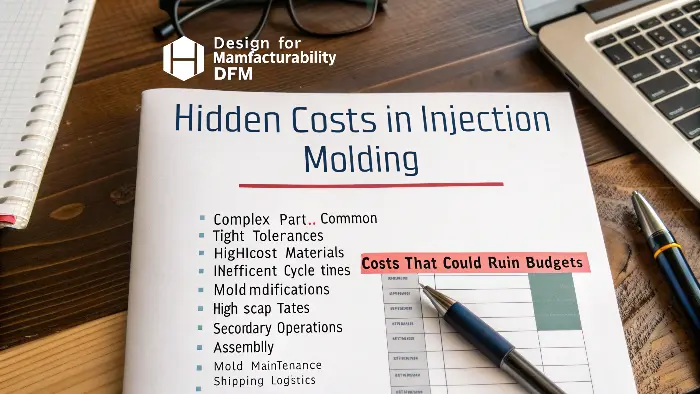
I’ve seen this happen countless times. A business owner like Michael comes to me with a project that’s already over budget, and we have to work backward to find the problems. The truth is, about 80% of your project’s total cost is determined long before the first piece of steel is cut. It’s locked in at the design stage. By understanding where these hidden costs hide, you can find them and design them out from the start, not after they’ve already cost you money.
What is the most important consideration when estimating the cost of injection molding tooling?
You’ve got a part design that looks perfect on your screen, but your quotes coming back out of the mold are astronomical. Now, you’ve got a thorny decision in front of you: take a huge hit to your finances or go back to design drawing boards at considerable expense and time. This unwanted obstacle will put your project in neutral and create a great deal of stress before you’ve even begun manufacturing.
Estimating cost is most critical in terms of part complexity. Undercuts, threads, or unnecessarily close tolerances that don’t allow easy ejection of the part out of the mold are the greatest cost opportunities. They necessitate costly and elaborate mold mechanisms in the form of slides, lifters, and precision machining. The simplest solution to managing tooling cost is by geometry simplification in terms of Design for Manufacturability (DFM).
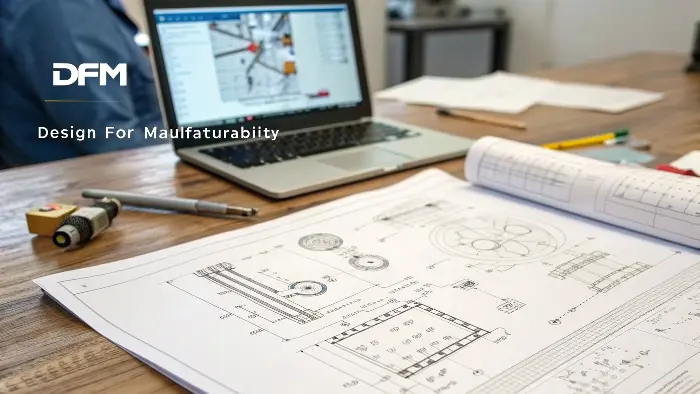
I constantly remind my clients that the mold is two sections of a piece of steel. The easiest and least expensive aspect is one which can be created and expelled simply by splitting those two halves apart. Each feature, which violates this rule, introduces a new mechanism, and each mechanism introduces a cost, complexity and yet another possible point of failure. This is the point at which the first, and often the greatest, undeclared expenses are located. You have to question every single aspect of your design before you settle on it and ask yourself; Is this truly necessary, can it be simplified?
How Part Design Directly Inflates Tooling Costs
Let’s break down exactly how design choices turn into dollar signs on your tooling quote.
-
Hidden Cost #1: Overly Complex Part Design (Undercuts)
An undercut is any feature that would get "stuck" when the mold opens. Think of a snap-fit clip on the side of a part. To release this, the mold needs a side-action, or a slide, which is a moving piece within the mold that pulls away before ejection. Each slide adds significant cost due to the precision machining and fitting required. A simple redesign, like adding a cutout so the clip can be formed in the main direction of pull, can sometimes eliminate the need for a slide entirely, saving thousands of dollars. -
Hidden Cost #2: Unnecessarily Tight Tolerances
Engineers often default to tight tolerances, but you must ask if they are all critical. The difference between holding a dimension to +/- 0.2 mm versus +/- 0.05 mm is enormous. The tighter tolerance requires more precise CNC machining, potentially slower and more expensive electrical discharge machining (EDM), more rigorous quality inspection, and more skilled labor. This can dramatically increase the cost of building and qualifying the mold.
| Feature | Standard Approach (Lower Cost) | High-Precision Approach (Higher Cost) |
|---|---|---|
| Tolerance | +/- 0.2 mm | +/- 0.05 mm |
| Undercut | Designed out | Requires complex slide/lifter mechanism |
| Surface Finish | Standard polish (SPI-C1) | Mirror polish (SPI-A1) |
| Resulting Mold Cost | Base Price | Potentially 2x-3x Base Price |
- Hidden Cost #3: Surface Finish Specifications
The texture of your part’s surface is created by the finish on the mold cavity. A standard machine-tool finish is relatively cheap. A high-gloss, mirror polish (SPI-A1) requires many hours of skilled manual labor. Likewise, applying a specific grain or texture (like a VDI finish) is a separate chemical etching process that adds cost. Always specify the simplest, most cost-effective finish that your product actually requires.
What is a critical factor affecting the cost of injection molding?
You’ve defined a producible part and selected a material with optimal technical properties. However, upon receiving production quotes back, cost per part is higher than what you estimated. You’re stumped, unsure of how to lower the cost of a part without having to yield a cheaper, low grade of material that could compromise your product performance.
One of the critical factors in terms of per-part cost is the interaction of raw material cost and cycle time in molding. Though high-performance engineering resins cost, of course, more per pound, oft-overlooked cycle time is usually the key driver of this cost. A troublesome-assembler’s-chest-nut or a slow-cooling-tough-guy-asphalt-material will remain in the injection molding machine longer, so it will cost more per part that you turn out. A few seconds per cycle difference will translate into tremendous savings in a production run.
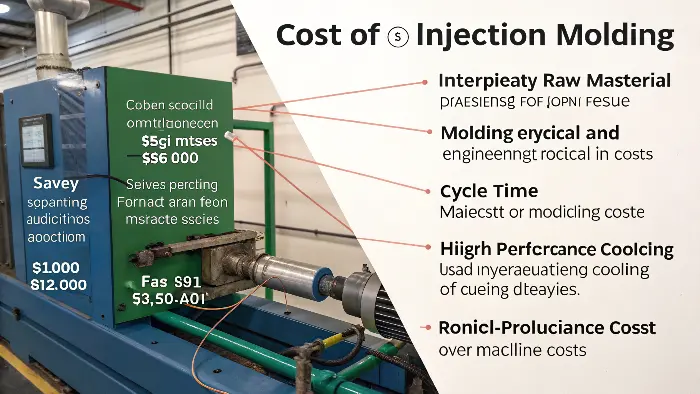
I’ve had many conversations with clients like Michael about this exact point. He once considered a specific grade of glass-filled polycarbonate for its strength. The material itself was only slightly more expensive than an alternative. However, its processing window was narrow and it required a significantly longer cooling time. We calculated that the extra 10 seconds of cycle time would increase the part cost by 15% over a 100,000-part run. This "hidden" machine time cost was far greater than the savings on the raw material. We ultimately found a different grade that met the strength requirements and had a shorter cycle time, saving the project a lot of money.
Balancing Material Performance with Production Efficiency
The best material choice isn’t just about technical specs; it’s about total production cost.
- Hidden Cost #4: Poor Material Selection
Don’t just look at the price per kilogram. Consider the material’s processability. Some materials are "forgiving" and run well across a wide range of temperatures and pressures. Others are sensitive and require a highly stable process to avoid defects, leading to higher scrap rates. A slightly more expensive but easy-to-mold material can be cheaper in the long run. Also, consider fillers. Glass or carbon fiber fillers add strength but are abrasive and will wear down the mold faster, leading to higher maintenance costs—another hidden expense.
| Material | Cost/kg | Processing Notes | Estimated Cycle Time | Total Cost Impact |
|---|---|---|---|---|
| Polypropylene (PP) | Low | Easy to process, fast cooling | 20 seconds | Low part price due to cheap material and fast cycle. |
| Polycarbonate (PC) | Medium | Requires high temp, longer cooling | 35 seconds | Higher part price from both material and machine time. |
-
Hidden Cost #5: Inefficient Cycle Time
The beating of your production cost is cycle time. It is divided into three major sections, which are injection time, cooling time, and mold-open/ejection time. The best part is the cooling, which is nearly always the longest part. It is important to have a well designed mold that has effective cooling channels. Although more complex solutions, such as conformal cooling channels, may increase the initial cost of the mold, they may reduce the cycle time to 20-30%. In high volume production, the investment is recovered in a very short period because it results in the reduction of the cost per part. A quotation should always ask after the estimated cycle time. It is one of the determinants of the experience of the molder and the quality of his/her mold design.
How can you reduce waste in injection molding?
Your production run is finished, but you discover that a significant number of parts have to be thrown out due to quality defects like warping or incomplete filling. This scrap material, wasted machine time, and the labor spent sorting good parts from bad are all eating directly into your profits. This feels like you’re paying for parts you can’t even use, making the entire operation less efficient and more expensive.
To save money by reducing waste, you will need to consider creating a steady, reproducible molding operation and part design that does not necessitate hand secondary operations. A steady operation eliminates flash, shorts, and sink marks, reducing scrap. Furthermore, by being so designed that it will come out of the mold as a finished part that does not need hand trimming, drilling, and assembly, major sources of labor cost and potential human error are eliminated. "Lights-out" manufacturing should be targeted.
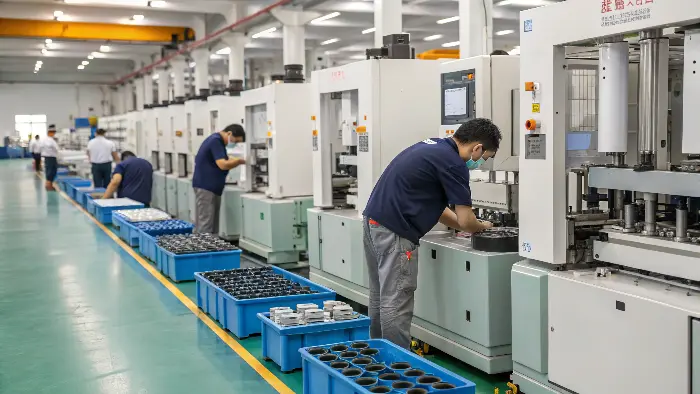
Those that fall out of the mold, fall into a box, and are ready to ship, are the most profitable ones. Whenever an individual is required to touch the portion once it has been molded, this becomes costly and creates a possibility of making mistakes. On one occasion, I assisted a customer who was hiring two full-time employees to only remove surplus plastic on a poorly-designed gate on each and every part. With the hot runner system, a new mold that had no vestige of a gate at all was co-invested with us. The mold was also more costly however, it saved more than the expense of the mold in the first year in labor.
Designing Out Waste and Extra Labor
Waste isn’t just scrapped plastic; it’s wasted time, labor, and energy.
-
Hidden Cost #6: High Scrap Rates
Defects are a direct result of a mismatch between the part design, mold design, and molding process.- Uniform Wall Thickness: The number one rule of plastic part design. Varying wall thicknesses cause the plastic to cool at different rates, leading to sink marks and warpage. This is a major cause of rejects.
- Proper Gating: The location and type of gate (where plastic enters the cavity) are critical. A poorly placed gate can cause cosmetic issues or structural weaknesses.
- A good molder will use DFM analysis to identify these potential issues and suggest design changes before the mold is built.
-
Hidden Cost #7: Secondary Operations
This is a huge source of hidden labor costs. Look for ways to design these out.- Trimming: Instead of a large tab gate that needs to be manually trimmed, can you use a pin-point or submarine gate that shears off automatically?
- Drilling Holes: Can the hole be molded in directly? If it’s on the side of the part, a simple side-action in the mold is often cheaper in the long run than paying someone to drill thousands of holes.
- Adding Graphics: Instead of applying a sticker or printing later, could you use in-mold labeling (IML)?
-
Hidden Cost #8: Assembly and Packaging
Never forget the final steps. If your product consists of multiple molded parts that need to be assembled, that’s a significant labor cost. Can they be redesigned into a single, more complex part? Can you use snap-fits instead of screws? Even custom packaging and boxing can add up. Consider these "end-of-line" costs early in the design phase.
Cost-Saving Strategies in Injection Molding
Optimize Part Design Manufacturability (DFM)
One of the most viable means of reducing the cost of injection molding is through Design for Manufacturability (DFM). In this strategy, the company concentrates on the simplification of designs of parts to minimize production difficulties and become more efficient.
Minimize Complexity: Geometries should be kept simple, there should be no unnecessary information inside and the wall thickness should be consistently made the same as much as possible. This minimizes the special tooling or additional finishing operations.
Eliminate Undercuts: Designs should not include undercuts or complex designs that would necessitate side actions, lifters or expensive mold parts.
Integrate Features: In cases where possible, multiple components can be cast in a single mold to reduce the need to assemble, and reduce the time spent on manufacturing parts.
Such optimization of designs enables you to make the molding process more effective, reduce the tooling requirements, and have shorter cycle times, which eventually reduces the cost of production.
Select the Right Material
Determining the optimal plastic to use in your part requires compromising between the cost and the performance you need.
Determine Performance Requirements: Determine the mechanical strength, thermal tolerance, and chemical resistance that your part requires. Less demanding applications can probably be adequately served by less expensive materials such as polypropylene (PP) or polyethylene (PE), whereas more sophisticated components might demand more high-performance plastics such as ABS or PEEK.
Think about Reusing or Remaking: In a large number of applications recycled resins or hybrid products will be able to reduce the cost of raw materials without affecting functionality.
Minimize Waste: Cooperate with your manufacturer to optimize the usage of materials helps in minimizing scrap and also minimizes the total costs of materials.
Under-engineering to meet the requirements of a project rather than overspending can allow you to avoid unnecessary spending and maintain budgets under control.
Collaborate with a Domestic Manufacturer.
A joint venture with a domestic injection molding firm like CKMold can have not only cost savings but also operational advantages.
Reduced Shipping and Delivery Time: When manufactured locally, there are no international freight costs and the lead times will be minimized. This will enable faster response and flexibility in meeting the changing market requirements. Even companies that are presently outsourcing overseas can enjoy reshoring production.
Improved Communication: Direct cooperation with a neighboring partner enhances the level of understanding and reactions. This reduces mistakes and any design or manufacturing difficulties are timely solved.
Tighter Quality Control: There are often stricter quality and compliance rules that apply to domestic suppliers and this results in more consistent products and reduced defects.
Such benefits provide you with better management of your supply chain, minimize the chances of unforeseen expenditures, and enhance delivery and quality reliability.
What is the rule of thumb for injection molding?
You’ve been called upon to get your product out soon and cheaply, so you focus on getting the lowest cost of both parts and mold. Short-term thinking makes it tempting to unintentionally sanction a simple part design in a hurry and choose that supplier whose rock-bottom price you accept. You worry this expediency will cost more in the long term, i.e., a tool that will wear out too soon or repeated quality problems that will cause production to grind to a halt.
First and foremost, it is always best to focus on the Total Cost of Ownership (TCO) rather than initial cost. Spend money and time up front in Design for Manufacturability (DFM). The more expensive mold made of good, efficient, low-scrap-high-quality steel will almost invariably cost less over time than a cheap tool requiring constant maintenance that produces sporadic parts. Be not penny-wise, pound-foolish.
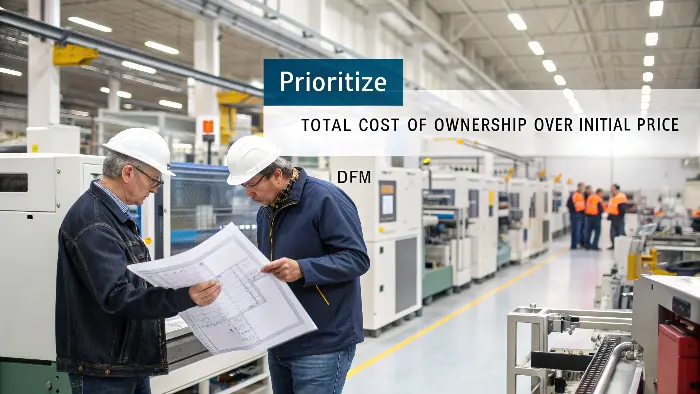
This is my fundamental philosophy that I have based my business. It is the distinction between a purchase of a tool and a strategic investment. It is not a bargain to have a cheap mold that collapses. I have witnessed savings of $5,000 on a mold by substituting hardened H13 with P20 steel that is soft. Then, within 100,000 cycles, the mold was obsolete and required significant and expensive repairs, which stopped their production line in weeks. The savings they had made in the initial stage were washed out numerous folds by the idle time and the cost of repairs. It is best considered in the following manner: what will this project cost me in its lifetime?
Focusing on Long-Term Value, Not Short-Term Price
Adopting a TCO mindset protects you from the last, and most deceptive, hidden costs.
-
Hidden Cost #9: Mold Maintenance and Repair
The lifespan of your mold is directly related to the quality of the steel used and the precision of its construction.- Soft Steel (e.g., P20): Cheaper, easier to machine. Good for prototypes or short production runs (e.g., <100,000 shots).
- Hardened Steel (e.g., H13, S136): More expensive and harder to machine, but much more durable. Required for long runs (500,000+ shots) or for molding abrasive materials like glass-filled nylon.
Investing in a hardened steel tool from the start prevents the hidden costs of frequent maintenance, repairs, and production downtime. A good supplier will guarantee their mold’s lifespan in writing.
-
Hidden Cost #10: Shipping and Logistics
For projects sourced overseas, this can be a major surprise if not planned for. As I’ve mentioned before, you must understand the shipping terms (Incoterms) in your quote. A price quoted as "EXW" (Ex Works) means you are responsible for every single cost after the mold leaves the factory door. A "FOB" (Free On Board) price is more predictable, as the supplier handles getting it to the port. You must also budget for import duties, taxes, and local delivery in your own country, as these are never included in the supplier’s price.
Ultimately, the golden rule is this: the time you spend on planning and design is the highest-leverage activity you can do. Every hour spent on DFM can save you ten hours of headaches and thousands of dollars in hidden costs later.
How A Trusted Supplier Control Costs
The way a Trusted Supplier such as CKMold can be used to control costs.
Having an established injection molding partner like CKMold could help make a big difference in ensuring the production costs remain under check. The key strength is that they are well versed in Design for Manufacturability (DFM) where they scrutinize the design of parts earlier to avoid unneeded complexity, minimize tooling needs, and decrease turnaround periods. This will avoid expensive respray work and the mold is efficient in the initial phase.
CKMold also supports companies to control the costs by advising the appropriate material selection in accordance to performance requirements and budget. They do not over-specify costly resins but rather advise their clients on less costly resins or mixed materials that qualify the application. They also know the local and global resin markets, and by means of this, the buyers can achieve improved prices and minimize waste by means of optimised utilization.
Efficient production management and tooling is another means CKMold will help save some costs. They reduce, through long-lasting, high precision molds which minimize downtime, increase the lives of the mold and reduce defects, which reduce the costs of manufacturing in the long run. Their high-technology machinery and automation are also more efficient in the cycle, which further reduces the per-unit cost.
Lastly, combining with a trusted supplier enhances the reliability of the supply chain. The uninterrupted quality management, clear communication, and timely delivery of CKMold assist manufacturers to avoid some unforeseen costs when delays, recall of the product, or quality problems occur. Such a combination of technical skills, efficiency in the processes, and quality support makes CKMold not only the supplier, but a cost-control partner.
Conclusion
The presence of the hidden costs in injection molding is not unavoidable; they are the outcomes of the lack of planning. You can gain control by quitting the first quote and looking through the lifecycle of your project. Len on making your part simple, selecting the appropriate material to perform and to be efficient, and invest on a good quality mold that will last long. This is a long-term strategy which will make the manufacturing project predictable, profitable, and successful.
